Strikingly beautiful, desert rose catches passerby’s attention every time they pass by.
Within the Adenium family, there are many smaller species that have been classified to help us identify the plants we’re having and know how to take better care of them.
In our list today, we will meet some of the three most common species and see some of their highlighted characteristics:
Then, we'll tour around six more lovely ones:
- Adenium Swazicum
- Adenium Somalense
- Adenium Crispum
- Adenium Boehmianum
- Adenium Oleifolium
- Adenium Socotranum
- Adenium Arizona
Umm umm what?! These can be overwhelming when you're just getting started. But trust us, you will remember & recognize each one the more you play around with them.
Let’s check them out right below!
But first, have you ever wondered...:
Why Adenium Was Named Adenium?
The first European that caught sight of the first ever adenium in its natural habitat was a German explorer named Pehr Forsskal. Back in 1761, Forsskal joined an exploration voyage to the region of Egypt, Arab and India under the sponsorship of the Danish king.
And in December 1762, just a year after that, in the country of Yemen he caught the first sight of an adenium. And maybe, from our guess only, the plant he saw was in spectacular bloom with beautiful shades of color, standing proud & elegant in a wild desert where most lifeforms turn dull.
The word "Aden" then was used to name this newly-explored specie of plant. In the early times, Aden was the former name of the country of Yemen and was the name referring to the Yemen region & the Arabian Peninsula spreading from the Red Sea to the Indian Ocean.
Below here you can see the Yemen region & the Gulf of Aden on the map:
/map-of-yemen-1937.jpg)
The place still exists to this date. And Aden is the starting place where people first found an Adenium:
/map-of-yemen-2015.jpg)
The humankind has ever since discovered and known about this spectacular desert plant for over hundreds of years.
Adenium Other Names:
- English: Desert Rose, Sabi Star, Impala lily, Karoose Rose, Elephant Foot
- French: Rose du desért, French asalée
- Thai: Chuan Chorn, Kalachuchi
- Portuguese: Rosa do deserto
Let's now capture this beauty & take a tour around the family of Adenium next:
3 Popular Adenium Desert Rose Species
1. Adenium Obesum (The Common Guy)
/adenium-obesum-desert-rose-plant.jpg)
Among all the other Adenium species, the Obseum is probably one of the most common ones you’ll see. This plant first appeared throughout the African Sub-Saharan region, spanning across an area from Senegal to Sudan and Kenya. They also grow abundantly in places like Tanzania, Somalia, and Socotra.
How Tall Does Adenium Obesum Grow
Adenium Obesum can grow between 3ft (0.9m) to over 9ft (2.7m) tall. The plant usually grows straight upwards with a greenish-gray trunk that is fat on the caudex and gets slimmer on the top and branches.
The leaves of Obesum look like a long droplet of water dripping down that are about a finger’s length. Let's have a closer look right here:
/adenium-obesum-leaves.jpg)
Some folks even find heart-shaped leaves on their plants, which is really cute.
The way nature arranges the leaves follows a spiral pattern. Leaves on the bottom layer are bigger and longer, and they get smaller when it comes up to the top. The higher leaves never shade out the lower ones.
Obseum flowers are tubular. The inside of the tube is light yellow. You’ll often see some thin thread-like pieces inside the tube. Those are the pistils of the flower, where it will receive pollen to get “pregnant” and bear fruits.
You might be in love with this:
/adenium-obesum-pink-flowers.jpg)
When Obesum first blooms, it gives quite a dark crimson red color. After some time, the color fades out. It’s more pink on the edges of the petals and more pale near the top of the tube.
Obesum blooms in the summer, but in many cases it can bloom near the end of the year if kept in a hot, humid environment. It produces lots of beautiful flowers and grows well in pots.
Here are some pictures of cute little Obesum blooms generously shared by one of our readers:
/Bloom%201.jpg)
/Bloom%202.jpg)
/Bloom%203.jpg)
/Bloom%204.jpg)
/Bloom%205.jpg)
/Bloom%206.jpg)
/Bloom%207.jpg)
/Bloom%208.jpg)
Continuing our exploration, you can see here that Obesum seeds are pretty small. But they are used a lot in cross-pollination to create new varieties.
/adenium-obesum-seeds.jpg)
Adenium Obesum: Identification Table
| Characteristics | Adenium Obesum |
|---|---|
| Leaves | Pointy at the joint & round at the edge. Like a water droplet |
| Flower | Light yellow inside with crimson red to pink petals |
| Trunk & Caudex | Greenish grey, fat caudex that gets slimmer on the way up to the branches |
| Average height | 3 – 9 ft / 0.9-2.7 m |
| Commonly found in | African regions like Somalia, Tanzania & Sudan |
| Blooming season | Summer & sometimes late fall |
If you would like an exploration into the adenium world in your own time, check out this fantastic book by Dr. Mark Dimmitt on Amazon:
| Best Picture Book for Adenium Collectors |
|---|
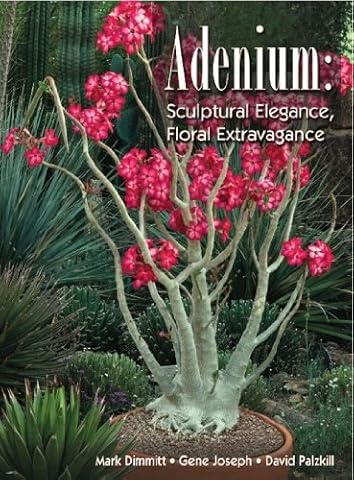 |
| 400+ beautiful pictures of common & rare adeniums |
| Details of species from African adventure trips |
| Expert tips on growing & propagating different varieties |
The Amazon page doesn't have a book preview, but here is a brief inside look video into the book:
>> Link YouTube (at 0:24):
Rosa do Deserto é ADENIUM, com 11 espécies = 2ª ParteLet's meet our friend Arabicum - the Chubby Guy next:
2. Adenium Arabicum (The Chubby Guy)
Looking at the name Arabicum, you may already guess that this Adenium specie originates from the Arabian Peninsula, especially in Saudi Arabia, Yemen, and Oman.
The Arabicum stands out from other species because of its strong, fat, and succulent caudex. Some Arabicum can grow from 3ft (0.9m) to over 11ft (3.3m) tall and 2ft or 60cm wide.
The trunk of Arabicum looks a bit like that of the Obesum. However, the Arabicum’s caudex is generally much fatter and bigger. We can see one example right here:
/adenium-arabicum.jpg)
There are fewer branches on the Arabicum. But as you know they say, quality over quantity. Each and every Arabicum branch makes up for the fewer number by being fat, strong, and firm.
/grafted-adenium-arabicum-multi-color.jpg)
The Arabicum doesn’t grow that many leaves. Most of them are clustered up near the top of the branches. Although the leaves are shorter than Obesum, Arabicum leaves have a much wider and larger surface.
Arabicum flowers have a dominant pale pink color, with a darker shade near the edges of the petals. This specie only produces pink flowers, unlike the Obesum (and its hybrids) which has many different colors. The petals are slightly pointed.
With the updated info from one of our readers and a master grower in Taiwan, it does seem that Arabicum also produces white flowers, which, is something rather new and interesting to us.
It could also be the specific plant or variety, as one of our readers in the Middle East noticed multiple different colors on their same one plant, and it is not grafted.
The way we can identify an Arabicum is by looking at the top of the flower tube. From inside the tube, there are five thin dark crimson red lines running out to the middle of each petal.
When you see an Adenium flower with these fine lines, a large caudex & fat trunks, you know for sure you’re looking at a beautiful Arabicum.
Their seeds are especially big and easy to germinate. Compared to Obesum, Arabicum seeds are much larger.
/adenium-arabicum-seeds-in-ziploc-bag.jpg)
Let's see a side-by-side comparison:
/arabicum-obesum-seeds.jpg)
This Arabicum guy doesn't mix well with Obesum in cross-pollination though. The successful fertilization rate is very low. In fact, Arabicum is mostly used for in-line breeding to create semi-dwarf species & less in cross-breeding or hybridizing.
>> Link YouTube:
Arabicum VarietiesHere are some varieties of arabicum:
Types Of Adenium Arabicum
- Adenium Yak Saudi
- Adenium SuayNamPetch
- Adenium MK-MK
- Adenium Godji
- And many more
Adenium Arabicum: Identification Table
| Characteristics | Adenium Arabicum |
|---|---|
| Leaves | Short, fat leaves that grow more concentrated near the top |
| Flower | Distinctive red marks on each petal, pale pink with darker shade near the edges |
| Seeds | Big seeds, easy to germinate |
| Trunk & Caudex | Fat caudex, big trunk that holds a good amount of water |
| Average height | 3 – 11 ft |
| Commonly found in | Arabian Peninsula, Saudi Arabia, Oman, Yemen |
| Blooming season | - |
If you're still wondering, here's a quick Obesum versus Arabicum "compare-off":
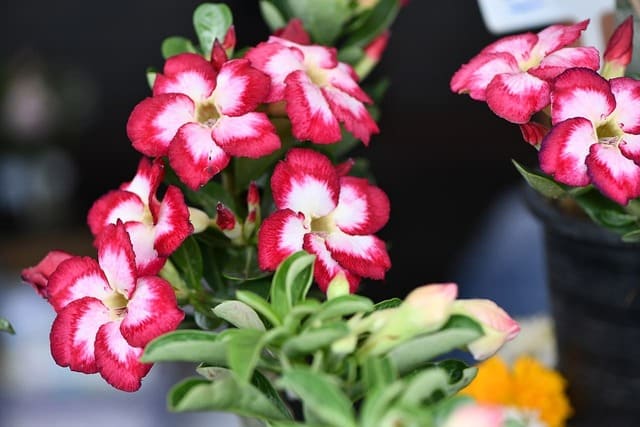
Finally, how about we meet the Flower Girl Multiflorum next?
But first, a quick question:
Do Desert Roses Have A Fragrance?
Most desert roses have a very mild or no fragrance at all to it. The Adenium Multiflorum specie particularly has a light but super sweet fragrance. This is its unique point compared to other species.
Speaking of Adenium Multiflorum, how about we check out this specie next:
3. Adenium Multiflorum (The Flower Gal)
Multiflorum desert rose is commonly found in South Africa, Mozambique, and Zimbabwe. This specie grows on sandy soil, dry forests, or shrub-grass savanna. The Multiflorum name has its root from Latin, which as you may guess, means many flowers.
The plant has a slender trunk and can grow up from 2ft to 9ft (0.6 - 2.7 m) tall. Its bark goes from glossy gray to brown. When its branch is broken off, Multiflorum produces a kind of watery latex. This sap is highly poisonous.
/adenium-multiflorum.jpg)
>> Link YouTube:
Adenium multiflorum Klotzsch (Southern Africa, from Zambia south)Compared to Obseum, Multiflorum tends to grow slower. For the most part of the year, you won’t see any flowers or leaves developed on the tree.
But this is what makes Multiflorum one of the best known and most striking South African adenium. The plant flowers near winter when other vegetation has mostly become dull.
Once it blossoms, you’ll be able to see an overwhelming beauty show-off of brilliant white, light pink, and crimson red.
Compared to the Obesum and Arabicum, Multiflorum flowers have much more vibrant colors, especially at the margins. It's honestly too beautiful to be missed.
/full-adenium-multiflorum.jpg)
You’ll also see some red stripes on the throat of the flower tube. This is not to be confused with Arabicum, this one has more stripes (about three) and the edges of the petals are slightly more wrinkled.
Multiflorum flowers have a light, super sweet fragrance. Their fruits consist of long, paired cylindrical follicles with brown seeds.
This specie is listed on the Red Data list of Swaziland where its existence is currently being threatened. National parks like Kruger National Park in Africa are trying all their best to protect this plant. So, protect the girl!
Due to its slower growth rate, it may not be as popular as the other species we’ve seen. This little gal is also more rare. But if you’re willing to spend the time taking care of it, you might just fall in love with it.
Adenium Multiflorum: Identification Table
| Characteristics | Adenium Multiflorum |
|---|---|
| Leaves | About 10cm long, glossy green, round at the tip |
| Flower | Striking crimson red near the edges, white lobes in the center, red stripes near the flower throat |
| Seeds | Brown seeds with silky hairs |
| Trunk & Caudex | Glossy grey to brown, has highly poisonous sap |
| Average height | 2 – 11 ft |
| Commonly found in | South Africa, Zimbabwe, Mozambique |
| Blooming season | Near winter |
That has been a lot of Adeni...Ums and Ahs! What we've seen so far are the 3 most popular ones. But don't tell me you've forgotten all their names. Dang folks, it's:
- the Common Guy Obesum
- the Chubby Guy Arabicum
- the Flower Gal Multiflorum.
See more here:
>> https://adenium.tucsoncactus.org/cultivat.html
/adenium-species-list-pin.jpg)
Coming up next:
6 More Rare Adenium Species
1. Adenium Swazicum
/adenium-swazicum-flowers.jpg)
Adenium Swazicum is native to the country of Swaziland. This variety can handle light dew, cold, and even wet environments. Because of this, it has high resistance to root rot.
While other varieties can be severely damaged even by a light frost, Swazicum can tolerate the upper 20sF (-2C) in a dry, dormant condition. Swazicum can also be watered throughout winter if kept warm. That is, at 80F/27C during the daytime and 50F/10C at night.
People usually use the Swazicum as the parent to cross-breed F1 generations of hybrid desert roses. These pair well with Obesum & Arabicum.
The plant is typically shorter than 3ft (0.9 m). Its trunk is slender and softer than most other species. The leaves are narrower but very long. Swazicum has unique flowers with a uniform color all around the flowers and inside the tubes. The colors range from light pink, dark pink, to crimson red.
Unlike the Multiflorum and Arabicum, Swazicum doesn’t have thin red stripes at the throat of the tube. It doesn’t have silky hairs there either. Swazicum flowers have quite round edges. The flower tube is narrow.
2. Adenium Somalense
The Somalense specie originates from Somalia and can be found in Tanzania, and Kenya. It doesn’t handle cold environments very well. The leaves fall off easily in the winter.
The tree grows comparatively fast and in some cases over 13ft (3.9 m). Mark Dimmitt has been able to grow a tree-like form of Somalense to 8ft (2.4m) tall from seed in as little as two years.
The caudex of Somalense is not as fat as the other species, but about the same size as the trunk. This specie has a tree-like structure with its longish trunk.
/adenium-somalense-plants.jpg)
With one exception of the sub-specie Somalense Nove which has quite a big caudex and a different look.
/adenium-somalense-nove.jpg)
Because of its longish, thick trunk, many adenium lovers use the Somalense to carve out beautiful adenium sculptures and stem towers.
>> Link Blog post:
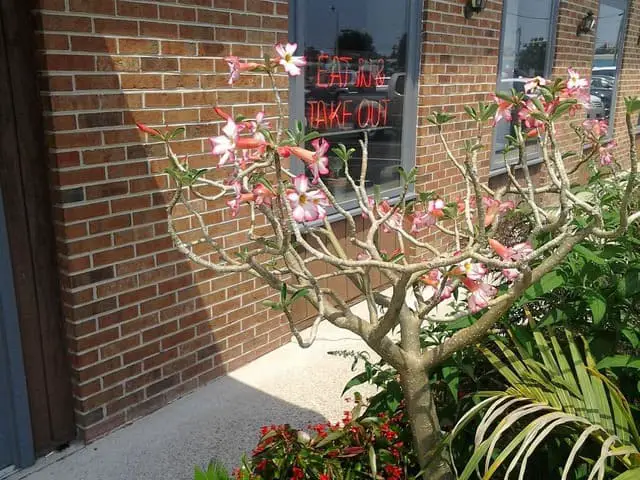
They look exquisite and do require a skillful pair of hands and a lot of patience to perfect. Some other folks don't like this art too much though. Because it hurts their plants. Some even question what will the plant look like 10 years after "surgery".
Somalense flowers are not as vibrant as Multiflorum. Their petals, however, are slightly bigger with wider tubes as well. They are pink in color. Somalense doesn’t have long pistils like Multiflorum.
Here are the Somalense seeds. They are pretty longish like their branch.
/somalense-seeds.jpg)
3. Adenium Crispum (Mini Somalense)
/adenium-crispum.jpg)
Crispum can be thought of as the dwarf version of the Somalense. This specie is very short. It’s usually shorter than 20 inches (50 cm). Bonsai lovers may choose to keep this at home due to its cute little form.
However, like Somalense, Crispum is sensitive to cold environments or those that are way too hot and humid.
It’s easy to identify a Crispum by looking at the flowers. This is the only Adenium specie we know of that has beautiful red stripes running from the inside of the tube out on the petals. Crispum has reddish, pink, and white shades on its flowers. The inside of the tube is slightly more yellow.
Their leaves are also smaller than their other big siblings. It makes sense because Crispum has a smaller form. The leaves are greenish gray with a non-glossy surface. It's easy to hand pollinate Crispum with other adenium species.
4. Adenium Boehmianum
/adenium-boehmianum.jpg)
The "Boeh" does look a bit like Swazicum, doesn't it! This little guy is native to Namibia and Angola. The tree grows slowly–sometimes it takes several years before it finally flowers. Whereas an Obesum may flower within 1.5 year or sometimes even earlier if grown from seeds.
Boehmianum has one of the largest leaves in the Adenium family. The leaves are greenish gray with round tips.
Boehmianum flowers in the late summer and early winter. Similar to Swazicum, this plant has uniformly colored flowers. It’s pale pink on the petals and all around the tube. It’s darker inside the tube. And just looks stunning.
To differentiate the Boehmianum from the Swazicum, we need to look at the leaves. Boehmianum has bigger leaves. And also, their leaves are non-glossy, unlike the glossy leaves the Swazicum specie has.
5. Adenium Oleifolium
/adenium-oleifolium.jpg)
Our "Olei" friend right here grows mostly in the Kalahari Desert of Southern Botswana, Namibia, and South Africa. This specie is small and very slow growing. It has a subterranean caudex that usually measures under a foot (about 30.48 cm) in length.
Leaves of Oleifolium are long, very narrow & have a greenish-gray color. They have parallel sides and usually measure about a finger’s length. There's some powdery dust on the surface of the leaves.
Oleifolium flowers are small with a variety of colors ranging from pink to red. The inside tube is yellow with long pistils. The plant blooms in late spring, from May to June.
Their follicles diverge 180 degrees, forming a straight line. It may take a year or so before the tree bears its first fruits.
6. Adenium Socotranum
/adenium-socotranum.jpg)
Among all other known Adenium species, Socotranum is probably one of the rare but highly sought-after ones. The plant is found in Socotra island in the Indian Ocean and Arabian Sea.
Similar to the Arabicum specie, the Socotranum has super fat caudex. The diameter of the caudex measures 5-6ft (1.5-1.8 m). This species can grow as tall as 13-16ft (3.9-4.8 m).
Soco light pink flowers start to reveal themselves from spring to mid-summer. The flowers are quite pointy at the tips and less wrinkled at the edges. The inside tube has a white-pink color with long nectar guides that are also pink.
Although the base of Socotranum looks solid and strong, it produces beautiful flowers that add an elegant touch to the overall strong-looking tree.
/adenium-socotranum-flowers.jpg)
Due to the perceived value of this variety, Thai adenium growers also develop their own specie called the Thai Socotranum, or Thai Soco for short (a hybrid between Arabicum x Golden Crown).
This specie has large caudex, no hairs on the leaves that could attract fungi & insects, and grows at a manageable size for smaller gardens and bonsai growers.
For grafting, Thai Soco is a bit of a challenge because it has lots of latex inside the branches. This makes the graft union hard to stick on together and chances of survival are thus lower. However, Thai Soco is overall a great cultivar.
/thai-soco-baby-bigger-plants.jpg)
Here's one Thai Soco priced at $30,000:
/adenium-thai-soco-million-baht.jpg)
Here are the Thai Soco seeds.
/thai-soco-seeds.jpg)
7. Adenium Arizona
Adenium Arizona itself is not a scientific classification. It's rather a cross between A. Obesum and A. Swazicum done by Dr. Mark Dimmitt. He named this after his hometown Arizona. Within this category, there is the amazing Crimson Star, one of the first truly red adenium ever created.
/crimson-star-adenium.jpg)
And that beauty takes us to:
The End of Our Adenium Tour
Wow, what a great exploration! Time does fly by, doesn't it. We hope this is not too overwhelming. But if you do feel so, it's perfectly normal. Sometimes we don't remember all of them either. The more you play around with these cuties, the more your love for them will grow.
At least, we hope that the information has given you some foundational knowledge about this attractive plant. If you think there are some mistakes we may have in the post, be sure to let us know. We're happy and open to your feedback. Thanks for reading & have an awesome time with your Adenium!
If you'd like to explore more species, check out:
- Adenium Dhofarense (a type of Obesum) | Source
- Adenium Yak Saudi (a type of Arabicum)
/adenium-yak-saudi.jpg)
- SuayNamPetch (SNP) Arabicum (small leaves)
/suaynampetch-arabicum-variety.jpg)
- Dorset Horn Adenium (DHA, dwarf version with curly leaves) | Source
/dorset-horn-adenium.jpg)
It has been fun exploring all the different kinds of adenium with you guys! I am intrigued by the all the various beauties and hope you are too. See you again next time at the garden.
Credits:
Share or pin this post!
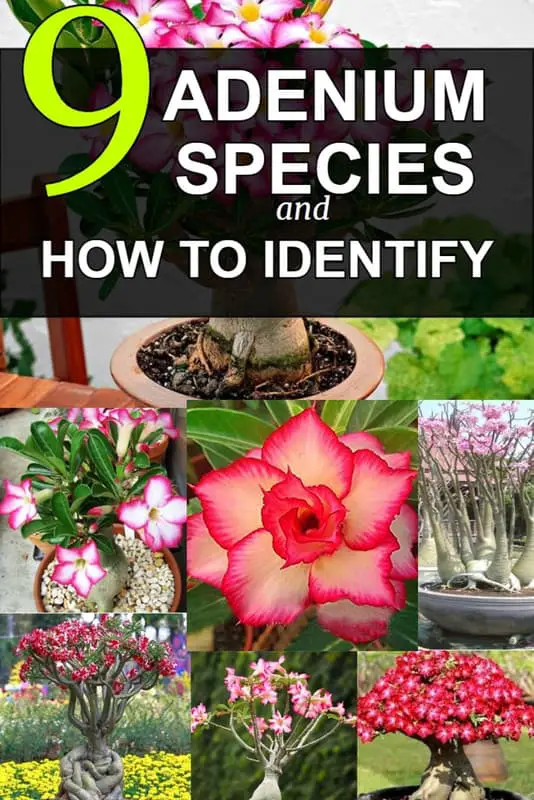

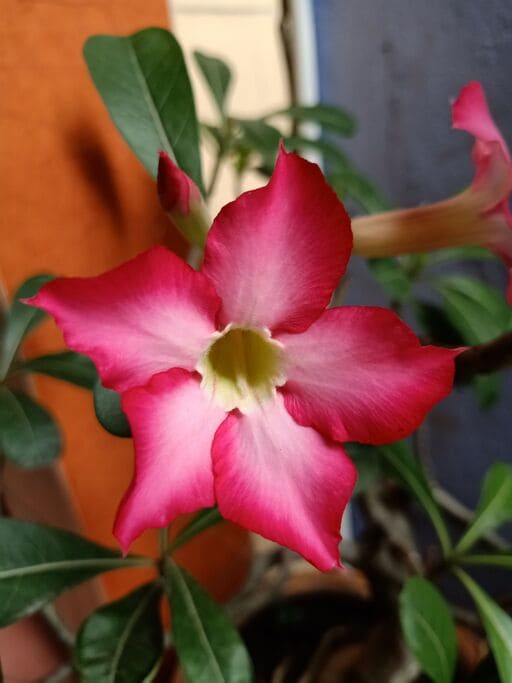

/adenium-dhofarense.jpg)